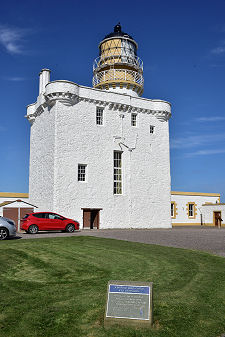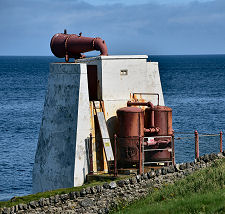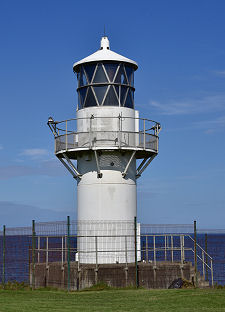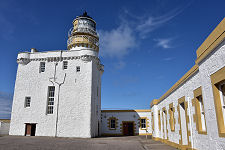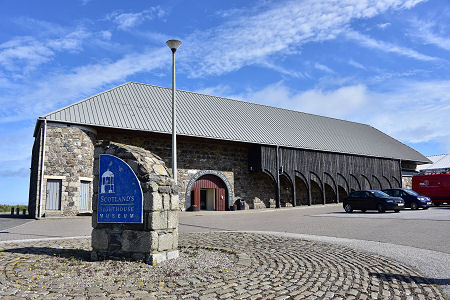 The Museum of Scottish Lighthouses |
Fraserburgh is home to the Museum of Scottish Lighthouses, a superb museum that is an essential stopping-off point for anyone who has ever been charmed or intrigued by the large number of lighthouses that punctuate Scotland's extremely complex and often dangerous coasts and coastal waters.
The museum has two distinct and equally important elements. The most obvious is the attractive stone building designed in the early 1990s specifically to house the lighthouse museum. Here you find the visitor reception, a café with magnificent sea views, and an excellent shop carrying a variety of goods including a good range of books focussing particularly on lighthouses and seafaring more widely across Scotland.
The museum building is also home to a series of galleries telling the story of Scottish lighthouses. It does so in a particularly compelling and engaging way, using sound recordings and, especially, carefully controlled dynamic lighting effects to bring to life the galleries and the exhibits within them.
It is easy to think of lighthouses as (usually) tall (usually) white buildings which (usually) occupy scenic or even spectacular coastal locations: because that is what visitors tend to see when travelling around Scotland. It is all too easy to forget that the buildings are only the means to an end, a way of carrying a mechanism that can transmit beams of light out to sea to warn seafarers of dangerous areas of coastline or simply help them locate their position more effectively. Lighthouses are really all about light. It is therefore highly fitting that the museum is also all about light. From your first encounter with full size lighthouse lenses on the ground floor and through much of the rest of the building, moving beams of light literally illuminate many of the items on view. (Continues below image...)
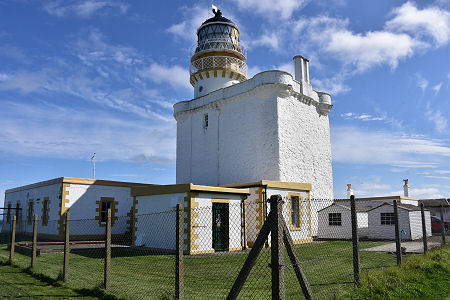 Kinnaird Head Lighhouse |
These exhibits range in size from the intimate to the huge. The collections of real lenses and lights on view tend to the "huge" end of the scale. But elsewhere are lighthouse and ship models and equipment and components that bring the scale down a little. And objects like the collection of lighthouse keys, the semaphore flags, crests, plaques and keepers' uniforms all help bring home that lighthouses also - at least until automation took over in the latter half of the 1900s - had a human element.
As we've described it so far, the Museum of Scottish Lighthouses is an impressive and informative place to visit, but one that could have been created just about anywhere around our coasts? Why, then, was it established in Fraserburgh?
The answer to that question involves a little history. The first efforts to place lights on dangerous stretches of Scotland's coast date back to a tower built on the Isle of May in the Firth of Forth in 1636, on top of which a coal fire was lit. Other locally funded and maintained lights of mixed effectiveness followed around parts of Scotland later in the same century.
The turning point came with a series of hugely destructive storms around Britain's, and especially Scotland's, coasts in 1782. The response, on 27 June 1786, was the enactment by the UK Parliament of "An Act for erecting lighthouses in the northern parts of Great Britain." To oversee the work, the Act established the Northern Lighthouse Trust, and they hired Thomas Smith, the Edinburgh inventor of a type of parabolic reflector and lamp, to put four lighthouses in place as quickly as possible.
The Northern Lighthouse Trust later became the Northern Lighthouse Board, and today it remains responsible for Scotland's lighthouses. Thomas Smith was the stepfather of Robert Stevenson, the first of the "Lighthouse Stevensons", the family who, generation after generation, were largely responsible for the building of Scotland's lighthouses until as recently as 1938 (and to whom the author Robert Louis Stevenson was something of a disappointment).
The location of Scotland's first "official" lighthouse, which lit up for the first time on 1 December 1787, was at Kinnaird Head, Fraserburgh. Built for speed of construction and for visibility on top of an existing tower house dating back to 1572, the lighthouse remained in operation until replaced by a nearby automated light in 1991. And here, finally, is the answer to our earlier question: why Fraserburgh? The Museum of Scottish Lighthouses is built on the edge of the town closest to Kinnaird Head, only a hundred yards or so from the Kinnaird Head Lighthouse: and an important part of a visit to the museum is a guided tour of Scotland's first official lighthouse.
Tours gather in the reception area of the museum, and from here you proceed past the buoy park and the forest of concrete posts once used to dry fishing nets to the compound housing the lighthouse. Nearby is the automatic light which replaced it, while a little nearer the shore is the foghorn, whose distinctive signal of a seven second blast every 75 seconds when visibility was less than 3½ miles finally fell silent in November 1987. Within the compound, visitors have the opportunity to view the engine house, which provided the power for the foghorn; and the keepers' cottages, fitted out as they would have been during the lighthouse's working life. But the highlight of your tour is a climb up the 72 steps within the tower to the light itself.
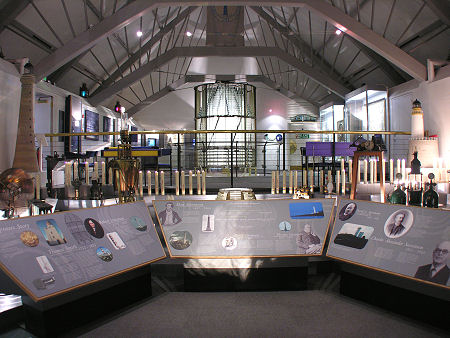 Inside one of the Museum Galleries |

|
|
|
Visitor InformationView Location on MapSTB 4 Star Visitor Attraction. Kinnaird Head, Stevenson Road, Fraserburgh, AB43 9DU. Tel: 01346 511022. Grid Ref: NJ 997 675 Museum Web Site Opening Hours Admission Accessibility What3Words Location: ///fence.gently.flotation |
 Lighthouse Lenses |
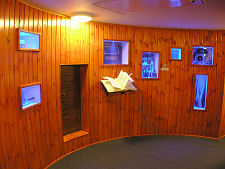 And Some of the Smaller Exhibits |
 Lights from Davaar and Scapa Flow |
 Stairs Linking Together Main Floors |
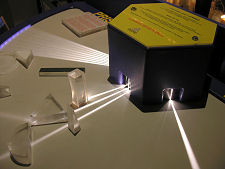 Prisms and Light |
 Upper Floor Displays |
 Interlocking Stones in the Base of the Bell Rock Lighthouse |
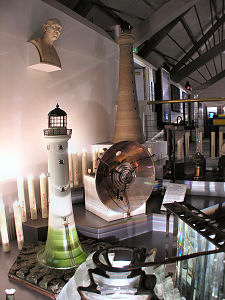 More Exhibits |
 Spiral Stairs |
 Lighthouse Keys |

